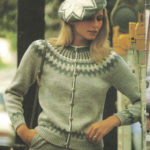Many people hesitate to tackle Fair Isle patterns as they involve stranding or weaving various colours of yarn and may appear complicated. There are a few problems, but they are easily solved.
Many patterns for colour knitting give a chart with each square representing one stitch. Working in stocking stitch you read the chart from right to left for knit rows and left to right for purl rows.
Stranding and Weaving
In working designs using two or more colours it is better to use stranding whenever possible, as weaving always shows a little on the right side.
Stranding the colours means carrying those not in use loosely across the back of the fabric, provided it is not over too many stitches. When a loose thread must pass over too many stitches, weave it over and under the colour in use at the centre point of stitches it passes over. There are no definite rules for holding the yams, and most knitters find their own method very quickly but the following suggestion, once mastered, is very easy; hold the first colour in the right hand and the second in the left. Work the first colour stitches in the normal way, but with the second colour stitches, insert needle into the stitch and hook yam through with the point of the needle. For an even finish one colour should be kept above and the other below. Tangles may be a problem in colour knitting, so here are a few hints: make a habit of straightening out yams at the end of each row. Don’t unwind too much yarn at once. Slip an elastic band round each ball to prevent further unwinding. If using small quantities of yam, wind them on to pieces of cardboard.





When working Fair Isle at any time, great care must be taken when carrying the yam across on the wrong side of the work. The strand of yarn should actually be looser than the stitches across which it is carried, to allow some elasticity in the completed fabric. When picking up the stranded yarn to use it again, it is advisable to s-t-r.e.t.c-h the preceding few stitches along your right-hand needle, thus forcing extra length into the strand of yarn before working the next stitch. This method is particularly important when working with a circular needle (e.g. on a round yoke), as the stitches tend to bunch together on the thin flexible part of the needle.


